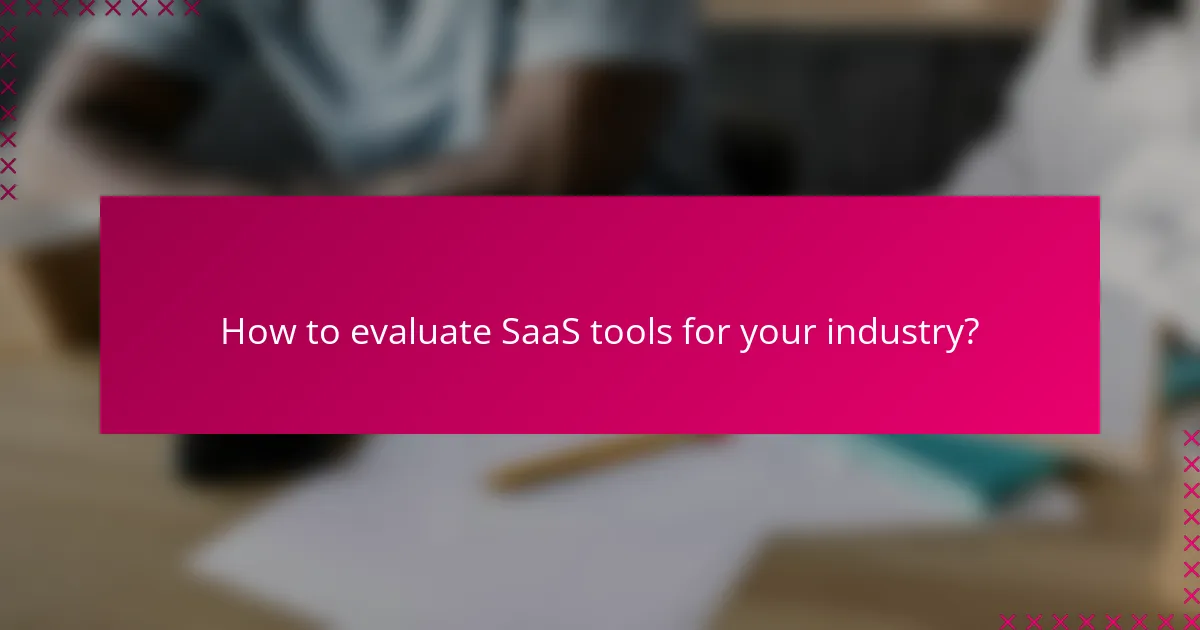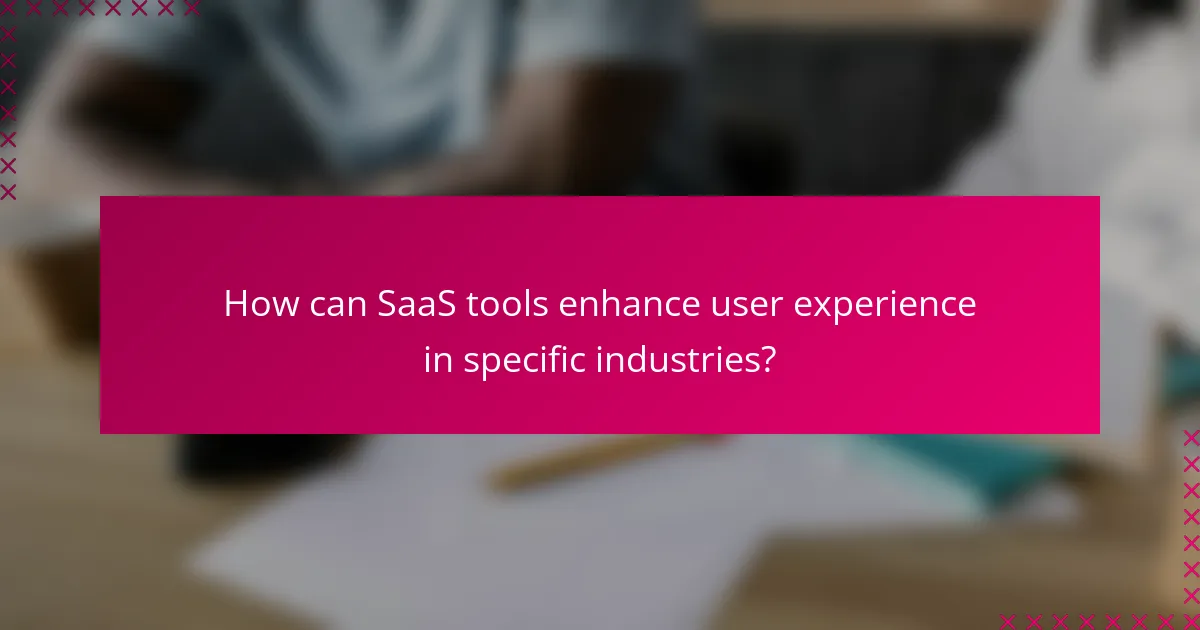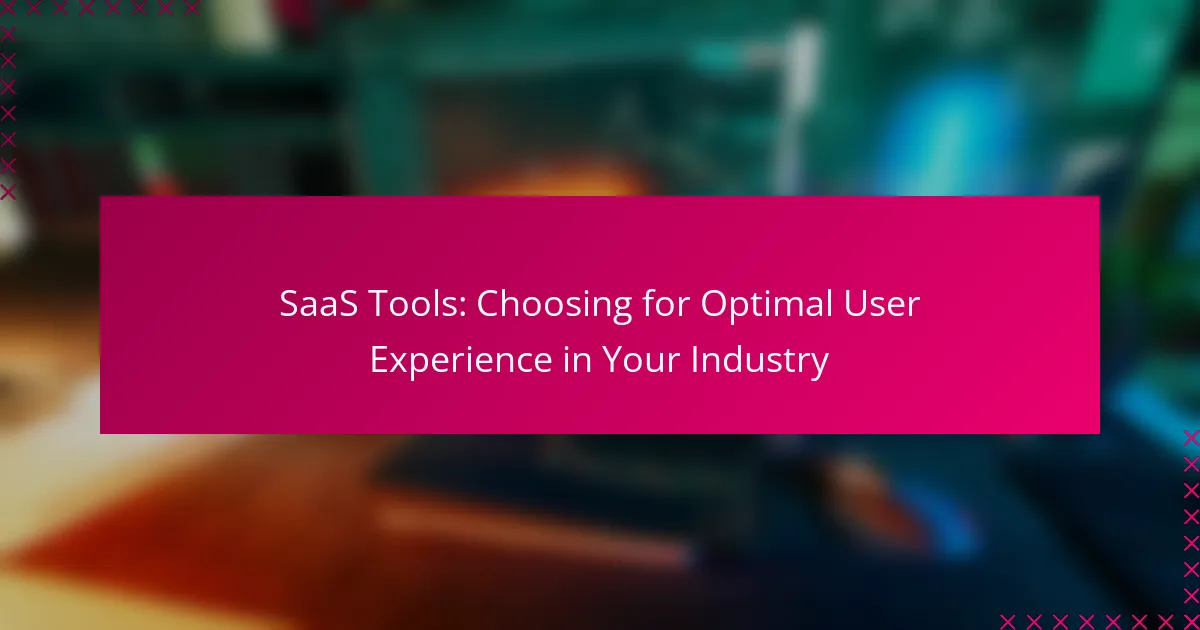Choosing the right SaaS tools is crucial for optimizing user experience in your industry. By focusing on functionality, usability, and integration capabilities, businesses can enhance customer interactions and streamline processes. Prioritizing features like scalability and customization ensures that the tools not only meet current needs but also adapt to future demands.

What are the best SaaS tools for user experience in Canada?
In Canada, the best SaaS tools for enhancing user experience focus on streamlining processes and improving customer interactions. Key options include HubSpot, Zendesk, Slack, Asana, and Mailchimp, each tailored to specific business needs.
HubSpot for CRM
HubSpot is a leading CRM platform that helps businesses manage customer relationships effectively. It offers tools for tracking interactions, automating marketing, and analyzing sales data, making it easier to nurture leads and retain customers.
When using HubSpot, consider its integration capabilities with other tools you may already use. This can enhance data flow and provide a more comprehensive view of customer interactions. Take advantage of its free tier to explore its features before committing to a paid plan.
Zendesk for customer support
Zendesk is a robust customer support platform that centralizes communication across various channels, such as email, chat, and social media. It enables businesses to respond to customer inquiries efficiently and track support metrics.
Utilizing Zendesk can significantly improve response times and customer satisfaction. Ensure your team is trained on the platform’s features, and consider setting up automated responses for common queries to save time and resources.
Slack for team collaboration
Slack is a popular communication tool that facilitates real-time collaboration among team members. It allows for organized conversations through channels, direct messaging, and file sharing, enhancing team productivity.
To maximize Slack’s effectiveness, establish clear guidelines for communication and encourage the use of threads to keep discussions focused. Integrating Slack with other tools, like Google Drive or Asana, can further streamline workflows and improve project visibility.
Asana for project management
Asana is a project management tool designed to help teams plan, track, and manage their work. It offers features like task assignments, deadlines, and progress tracking, making it easier to stay organized and meet project goals.
When implementing Asana, start by creating clear project templates to standardize processes. Regularly review project timelines and adjust tasks as needed to keep everyone aligned and accountable.
Mailchimp for email marketing
Mailchimp is an email marketing platform that allows businesses to create, send, and analyze email campaigns. It provides user-friendly templates and automation features to engage customers effectively.
To get the most out of Mailchimp, segment your audience based on behavior and preferences. This targeted approach can lead to higher open and click-through rates. Regularly analyze campaign performance and adjust your strategies to improve engagement over time.

How to evaluate SaaS tools for your industry?
Evaluating SaaS tools for your industry involves assessing their functionality, usability, and compatibility with your existing systems. Focus on user experience, integration options, and support services to ensure the tool meets your specific needs.
Assess user interface design
A user-friendly interface is crucial for maximizing productivity and minimizing training time. Look for tools that offer intuitive navigation, clear labeling, and a visually appealing layout. Consider conducting user testing with potential users to gather feedback on the interface.
Check if the design aligns with your team’s workflow. For instance, if your industry relies on data visualization, ensure the tool provides customizable dashboards and easy access to key metrics. A well-designed interface can significantly enhance user satisfaction and engagement.
Check integration capabilities
Integration capabilities determine how well a SaaS tool fits within your existing technology stack. Evaluate whether the tool can seamlessly connect with other software you use, such as CRM systems, project management tools, or accounting software. Look for APIs or pre-built integrations that simplify this process.
Consider the potential for data silos. Tools that do not integrate well may lead to duplicated efforts and inconsistencies in data. Aim for solutions that support popular platforms in your industry to ensure smooth data flow and operational efficiency.
Review customer support options
Robust customer support is essential for resolving issues quickly and minimizing downtime. Investigate the support options available, such as live chat, email, phone support, and comprehensive documentation. A responsive support team can make a significant difference in your experience with the tool.
Check the availability of support during your business hours. If your operations run outside typical hours, look for providers that offer 24/7 support. Additionally, read user reviews to gauge the effectiveness of their support services and response times.

What are the key features to look for in SaaS tools?
When selecting SaaS tools, prioritize features that enhance user experience, such as scalability, customization, and mobile accessibility. These elements ensure that the software can adapt to your business needs and provide a seamless experience for users.
Scalability for growth
Scalability is crucial for accommodating increasing user demands and data volume without compromising performance. Look for SaaS solutions that can easily adjust resources, such as storage and processing power, as your business expands.
Consider platforms that offer tiered pricing models, allowing you to start with basic features and upgrade as necessary. This flexibility can help manage costs effectively while ensuring that the tool grows with your organization.
Customization options
Customization options enable businesses to tailor SaaS tools to their specific workflows and branding. Evaluate whether the software allows modifications in user interfaces, features, and functionalities to align with your operational needs.
Tools that offer APIs or integration capabilities with existing systems can enhance customization. This ensures that the SaaS solution fits seamlessly into your current technology stack, improving overall efficiency.
Mobile accessibility
Mobile accessibility is essential for users who need to access SaaS tools on the go. Ensure that the software provides a responsive design or dedicated mobile applications to facilitate usability across various devices.
Check for features like offline access and mobile-specific functionalities, which can enhance user experience. A strong mobile platform can significantly boost productivity, especially for teams that operate remotely or travel frequently.

How do pricing models affect SaaS tool selection?
Pricing models significantly influence the selection of SaaS tools by determining the overall cost, flexibility, and perceived value. Understanding the different pricing structures can help businesses choose a solution that aligns with their budget and usage needs.
Subscription vs. one-time payment
Subscription pricing typically involves recurring payments, which can be monthly or annually, allowing for continuous access to the software. This model often includes updates and support, making it a good choice for businesses that require ongoing service and features.
In contrast, a one-time payment grants permanent access to the software but may not include future updates or support. This option can be more cost-effective in the long run for companies that prefer to manage their software without ongoing fees.
Free trial availability
Free trials allow potential users to test a SaaS tool before committing to a purchase, which can be crucial for evaluating usability and features. Many providers offer trials ranging from a week to a month, giving businesses the chance to assess whether the tool meets their needs.
When considering free trials, look for those that offer full access to features rather than limited versions. This ensures a comprehensive evaluation of the tool’s capabilities and helps avoid future dissatisfaction.
Tiered pricing structures
Tiered pricing structures provide different levels of service at varying price points, catering to businesses of different sizes and needs. Common tiers include basic, professional, and enterprise levels, each offering a distinct set of features and support options.
When evaluating tiered pricing, consider your company’s current and future needs. Opting for a higher tier may provide additional features that could enhance productivity, but ensure that the benefits justify the increased cost. It’s advisable to compare the features of each tier closely to avoid overpaying for unnecessary capabilities.

What are the common pitfalls in choosing SaaS tools?
Common pitfalls in selecting SaaS tools include ignoring user feedback, overlooking hidden costs, and neglecting data security. These mistakes can lead to poor user experiences, unexpected expenses, and vulnerabilities that could compromise sensitive information.
Ignoring user feedback
Failing to consider user feedback can result in choosing tools that do not meet the actual needs of your team. Engaging users in the selection process helps identify essential features and usability concerns that may not be apparent to decision-makers.
To avoid this pitfall, conduct surveys or focus groups to gather insights from potential users. Aim for a diverse range of opinions to ensure the selected tool enhances productivity and satisfaction across different roles.
Overlooking hidden costs
Many organizations underestimate the total cost of ownership when selecting SaaS tools. Beyond the subscription fees, consider additional expenses such as implementation, training, and ongoing support, which can significantly impact your budget.
To mitigate this risk, create a comprehensive cost analysis that includes all potential expenses. Compare different providers and their pricing structures, looking for any hidden fees or long-term commitments that could affect your financial planning.
Neglecting data security
Data security is a critical factor that is often overlooked when choosing SaaS solutions. Failing to prioritize security can expose your organization to data breaches and compliance issues, especially if sensitive information is involved.
Ensure that any SaaS provider complies with relevant regulations, such as GDPR or HIPAA, and offers robust security measures like encryption and regular audits. Evaluate their incident response plans and customer reviews regarding security practices to make an informed decision.

How can SaaS tools enhance user experience in specific industries?
SaaS tools can significantly improve user experience by providing tailored solutions that streamline processes and enhance accessibility within various industries. These tools often leverage cloud technology to offer scalable, user-friendly interfaces that cater to specific sector needs.
Healthcare: Telemedicine platforms
Telemedicine platforms are SaaS solutions that enable healthcare providers to offer remote consultations and services to patients. These tools enhance user experience by allowing patients to access medical care from the comfort of their homes, reducing travel time and wait periods.
When selecting a telemedicine platform, consider features such as video conferencing quality, appointment scheduling, and integration with electronic health records (EHR). It’s essential to choose a platform that complies with regulations like HIPAA in the U.S. to ensure patient data security.
Common pitfalls include overlooking user training and support. Ensure that both healthcare providers and patients are comfortable using the platform. A good practice is to offer tutorials and customer support to facilitate smooth onboarding.
